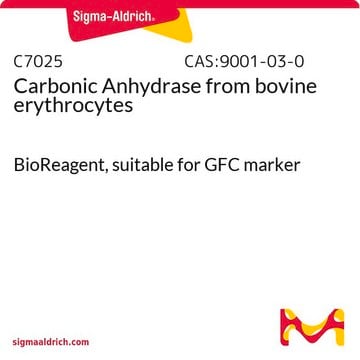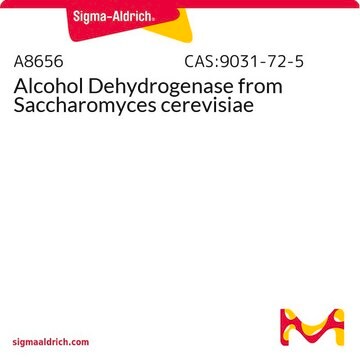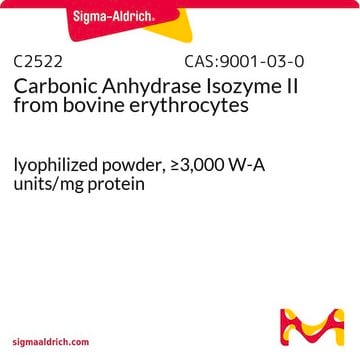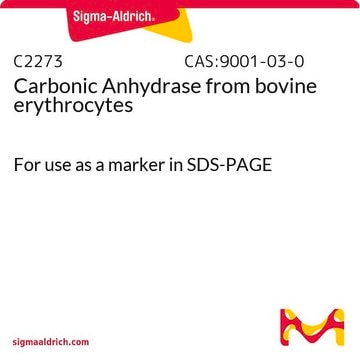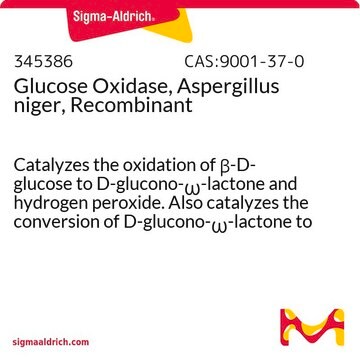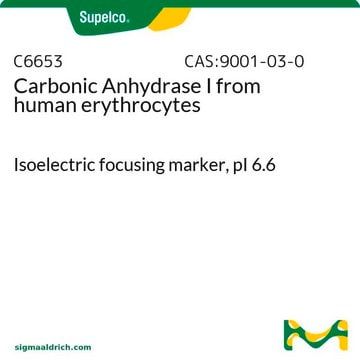The activity of this enzyme is established using a 0.02 M Tris buffer with a starting pH of 8.3 at 0°C. One unit will cause the pH of a 0.02 M Trizma buffer to drop from 8.3 to 6.3 per min at 0°C. However, the optimum pH and temperature is highly dependent on the specific application. There are a number of publications regarding the working parameters for this material. Please see the link below to review an example:
https://pubmed.ncbi.nlm.nih.gov/10701452/#:~:text=It%20was%20determined%20that%20the,61706%20Dalton%20by%20gel%20filtration.
Kluczowe dokumenty
C2624
Carbonic Anhydrase from bovine erythrocytes
≥95% (SDS-PAGE), specific activity ≥3,500 W-A units/mg protein, lyophilized powder
Synonim(y):
Carbonic Anhydrase from bovine erythrocytes, Carbonate Dehydratase, Carbonate Hydrolyase
Wybierz wielkość
1530,00 zł
Wybierz wielkość
About This Item
1530,00 zł
Polecane produkty
pochodzenie biologiczne
bovine erythrocytes
Próba
≥75% protein basis (biuret)
≥95% (SDS-PAGE)
Formularz
lyophilized powder
aktywność właściwa
≥3,500 W-A units/mg protein
rozpuszczalność
deionized water: >10 mg/mL
temp. przechowywania
2-8°C
Szukasz podobnych produktów? Odwiedź Przewodnik dotyczący porównywania produktów
Zastosowanie
Działania biochem./fizjol.
Definicja jednostki
Hasło ostrzegawcze
Danger
Zwroty wskazujące rodzaj zagrożenia
Zwroty wskazujące środki ostrożności
Klasyfikacja zagrożeń
Resp. Sens. 1
Kod klasy składowania
11 - Combustible Solids
Klasa zagrożenia wodnego (WGK)
WGK 3
Temperatura zapłonu (°F)
Not applicable
Temperatura zapłonu (°C)
Not applicable
Wybierz jedną z najnowszych wersji:
Certyfikaty analizy (CoA)
Nie widzisz odpowiedniej wersji?
Jeśli potrzebujesz konkretnej wersji, możesz wyszukać konkretny certyfikat według numeru partii lub serii.
Masz już ten produkt?
Dokumenty związane z niedawno zakupionymi produktami zostały zamieszczone w Bibliotece dokumentów.
Klienci oglądali również te produkty
-
What is recommand usage temperature and pH range?
1 answer-
Helpful?
-
-
What is the recommended storage conditions for "Carbonic Anhydrase, from bovine erythrocytes?
1 answer-
The recommended storage conditions for Solution of Carbonic Anhydrase, from bovine erythrocytes may be frozen at –20 °C for future use. It is advised to avoid repeated freezing and thawing. Stock solutions may be dispensed into working aliquots, frozen, and then discarded after 2–3 uses.
Helpful?
-
-
What is the isozyme I or isozyme II of Carbonic Anhydrase from bovine erythrocytes (C2624 Carbonic Anhydrase)?
1 answer-
The product C2624, Carbonic Anhydrase from bovine erythrocytes, consists mainly of CA II. However, there are also small levels of CA I and CA IV present.
Helpful?
-
-
Is it possible to obtain information about the type of Carbonic Anhydrase (I or II) included in item C2624-carbonic anhydrase?
1 answer-
Product C2624, Carbonic Anhydrase from bovine erythrocytes, with a purity of ≥95% (SDS-PAGE), consists predominantly of CA II, with small levels of CA I and CA IV present.
Helpful?
-
Active Filters
Nasz zespół naukowców ma doświadczenie we wszystkich obszarach badań, w tym w naukach przyrodniczych, materiałoznawstwie, syntezie chemicznej, chromatografii, analityce i wielu innych dziedzinach.
Skontaktuj się z zespołem ds. pomocy technicznej
